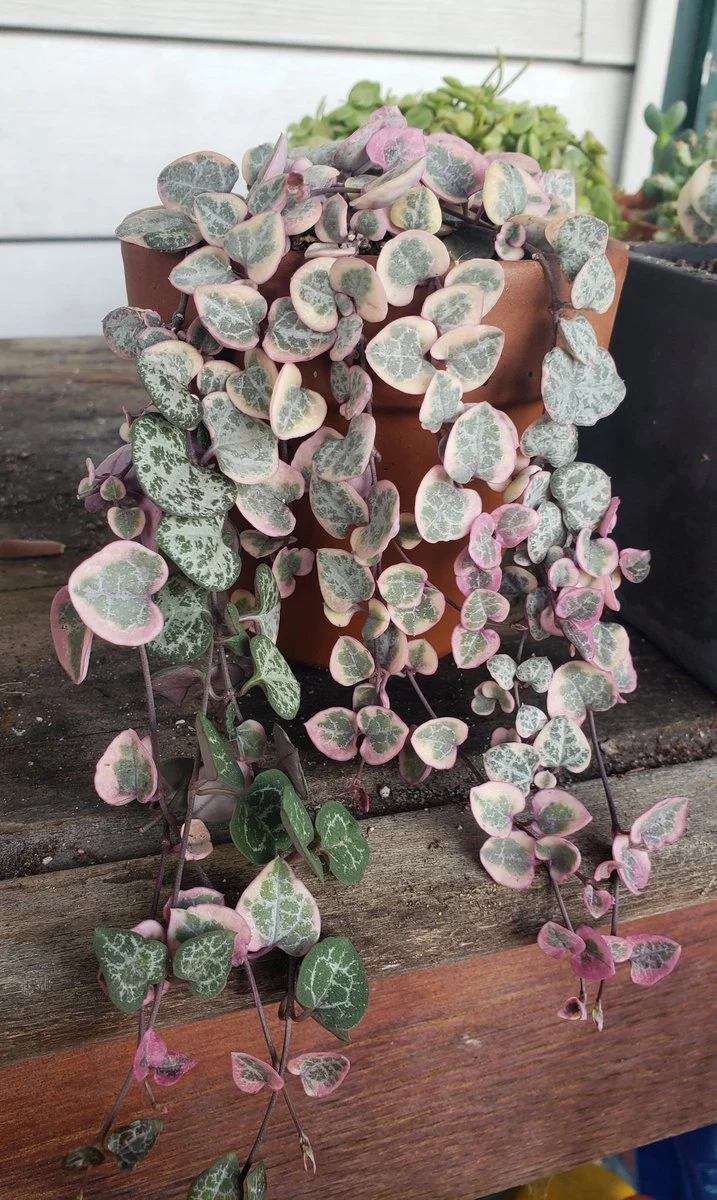The Pink String of Hearts (Ceropegia woodii), also known as Rosary Vine or Chain of Hearts, is a beautiful, trailing succulent with heart-shaped leaves and subtle pink tones. It’s a popular choice for hanging baskets or as a decorative plant in containers due to its unique appearance. Here’s a care guide to help you keep your Pink String of Hearts thriving:
1. Light Requirements
- Bright, Indirect Light: This plant thrives in bright, indirect light. Direct sunlight can scorch the leaves, causing them to turn brown or burn. A spot near a window with filtered light is ideal.
- Tolerates Some Direct Sun: While it prefers indirect light, the Pink String of Hearts can tolerate a bit of direct sunlight, especially in the morning or late afternoon.
2. Watering
- Allow Soil to Dry Out: Like most succulents, Pink String of Hearts is drought-tolerant and prefers to dry out between waterings. Water thoroughly when the top 1-2 inches of soil feel dry, but avoid letting it sit in water.
- Watering Frequency: In warmer months (spring and summer), it may require more frequent watering, but in the winter, it can go longer between waterings due to its dormant growth phase.
- Avoid Overwatering: Be careful not to overwater, as this can lead to root rot. Ensure the pot has good drainage to prevent water from accumulating at the bottom.
3. Soil
- Well-Draining Soil: Pink String of Hearts prefers well-draining soil, such as a cactus or succulent mix, which prevents water retention around the roots. If you’re using a general-purpose potting mix, consider adding perlite or sand to improve drainage.
- pH Level: This plant prefers slightly acidic to neutral soil, with a pH level of around 6.0 to 7.0.
4. Temperature and Humidity
- Ideal Temperature: It thrives in warm temperatures between 60°F to 80°F (15°C to 27°C). It’s sensitive to frost, so avoid placing it in areas where it could be exposed to cold temperatures (below 50°F or 10°C).
- Humidity: Pink String of Hearts is relatively tolerant of dry air, but it will appreciate some humidity, especially in the winter months. Regular indoor humidity levels are usually fine, but if the air is very dry, occasional misting can help.
5. Fertilizing
- Feed Sparingly: Fertilize your Pink String of Hearts during the growing season (spring and summer) using a diluted, balanced liquid fertilizer about once a month. Avoid fertilizing in the fall and winter when the plant’s growth slows down.
- Avoid Over-fertilizing: Over-fertilizing can result in leggy growth, so it’s best to err on the side of caution.
6. Pruning and Maintenance
- Pruning: Trim back any leggy or overgrown stems to maintain the plant’s shape and encourage fuller growth. You can also propagate the cuttings (more on that below).
- Cleaning Leaves: Gently wipe the leaves with a damp cloth to remove any dust or debris that might accumulate. This will help the plant stay healthy and allow it to better photosynthesize.
7. Repotting
- When to Repot: Repotting is generally needed every 1-2 years or when the plant outgrows its current pot. Choose a pot that is 1-2 inches larger in diameter than the current one.
- Repotting Tips: When repotting, ensure the new pot has good drainage to prevent water from collecting at the bottom. Be gentle with the plant’s trailing vines to avoid breaking them during the process.
8. Pests and Diseases
- Common Pests: Pink String of Hearts can be susceptible to pests like aphids, mealybugs, and spider mites. Regularly inspect the plant for any signs of infestation and treat with insecticidal soap or neem oil if needed.
- Fungal Problems: Avoid overwatering, as excess moisture can cause root rot and fungal diseases. Ensure the plant has proper drainage and airflow to stay healthy.
9. Winter Care
- Reduced Watering in Winter: During the winter months, the plant enters a dormant phase, requiring less water. Water sparingly and avoid fertilizing during this period.
- Protection from Cold: Keep the plant away from drafts and cold windows during winter to avoid any damage from chilly air.
10. Propagation
- Stem Cuttings: The Pink String of Hearts can be propagated easily from stem cuttings. Snip a healthy piece of stem with a few leaves attached, and place it in water or directly into well-draining soil.
- Rooting: If propagating in water, wait until roots form (which can take a few weeks) before transplanting into soil. If propagating in soil, keep the soil moist until new growth begins.
By following these care guidelines, your Pink String of Hearts will continue to grow beautifully and make a charming addition to your plant collection.


